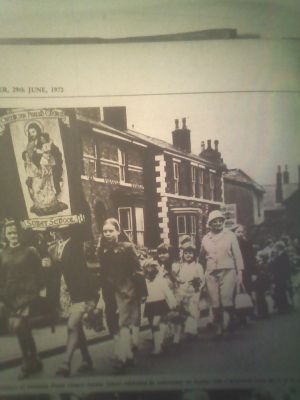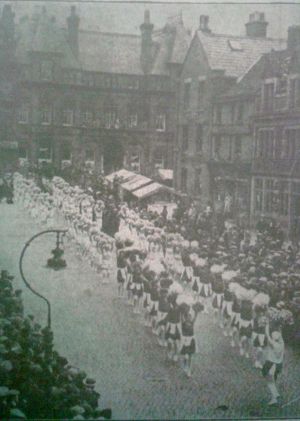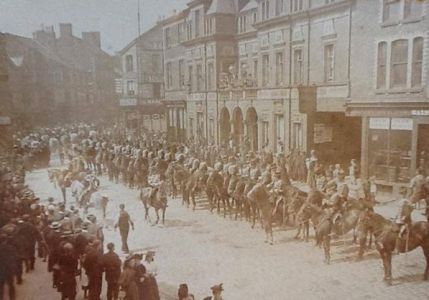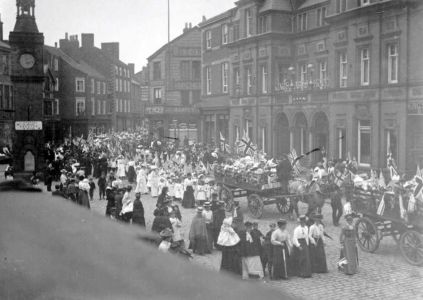Home » Posts tagged 'Clock Tower'
Tag Archives: Clock Tower
Ormskirk On Parade
Ormskirk On Parade

Gala Day in Ormskirk
The people of Ormskirk have always enjoyed a good parade. Traditional events like the Ormskirk Gala, the District Agricultural Show and the Empire Day parades were highlights in the town. Coupled with the various Coronations, Jubilees and various Anniversary parades, the town has some wonderful celebrations to look back on.
The town Gala was a huge event, spread across various venues in the town and over a couple of days, dressing up was popular and dressing up and riding a bike was even more popular with prizes for the most imaginative turnouts.
The Lancashire Hussars parade down Moor Street
The local Agricultural Show attracted exhibitors from all over the United Kingdom and the standard of entry and judges in the livestock, Poultry and Agricultural produce was apparently extremely high with some very generous prizes for best in show in all categories.
The local venues included the Victoria Athletic Grounds off Southport Road, owned by James Eastham and used not only for the various sporting elements of the Gala but also the judging of the various elaborate floats and tableaux.

The parade on Empire Day, 24th May 1902
The first Empire Day held on 24th May 1902 and we have images of the event in Ormskirk as the parade passes the King’s Arms, Moor Street.
The Parish Church held a Sunday School Anniversary, or Walking Day, in July each year when the children walked from Greetby Fields, along Stanley Street, Moor Street and then up Church Street for a special service in the Church.
Military parades in the town were held on many occasions and Ormskirk Bygone Times holds a number of images from across the years, if anyone would like to share photos and stories of the town’s social events please visit our page at facebook.com/Ormskirkbygonetimes
var GmediaGallery_4;
jQuery(function () {
var settings = {“lockheight”:”0″,”catButtonColor”:”48220b”,”scrollBarTrackColor”:”48220b”,”thumbLoaderColor”:”48220b”,”imageTitleColor”:”ffffff”,”ID”:”4″,”moduleUrl”:”http:\/\/ormskirkbygonetimes.co.uk\/wp-content\/plugins\/grand-media\/module\/afflux”,”pluginUrl”:”http:\/\/ormskirkbygonetimes.co.uk\/wp-content\/plugins\/grand-media”,”libraryUrl”:”http:\/\/ormskirkbygonetimes.co.uk\/wp-content\/grand-media”};
var content = [{“cID”:”ormskirk-on-parade_3″,”name”:”Ormskirk On Parade”,”description”:””,”data”:[{“id”:”14″,”image”:”\/image\/Miss_leatherbarrow_2_.jpeg”,”thumb”:”\/image\/thumb\/Miss_leatherbarrow_2_.jpeg”,”title”:”A Sunday School Parade on Stanley Street in the early 1960s”,”description”:””,”link”:””,”date”:”2016-01-13 14:09:36″,”views”:0,”likes”:0,”websize”:[960,1280],”thumbsize”:[300,400]},{“id”:”13″,”image”:”\/image\/aughton_belles.jpg”,”thumb”:”\/image\/thumb\/aughton_belles.jpg”,”title”:”May Day Parade 1932″,”description”:””,”link”:””,”date”:”2016-01-13 14:09:30″,”views”:0,”likes”:0,”websize”:[684,960],”thumbsize”:[300,421]},{“id”:”12″,”image”:”\/image\/gala-day-postcard-ebay.jpg”,”thumb”:”\/image\/thumb\/gala-day-postcard-ebay.jpg”,”title”:”Gala Day in Ormskirk”,”description”:””,”link”:””,”date”:”2016-01-13 14:07:55″,”views”:0,”likes”:0,”websize”:[722,469],”thumbsize”:[462,300]},{“id”:”11″,”image”:”\/image\/lancashire-hussars-2.jpg”,”thumb”:”\/image\/thumb\/lancashire-hussars-2.jpg”,”title”:”The Lancashire Hussars parade down Moor Street”,”description”:””,”link”:””,”date”:”2016-01-13 14:07:55″,”views”:0,”likes”:0,”websize”:[597,417],”thumbsize”:[429,300]},{“id”:”10″,”image”:”\/image\/parade-empire-day-6.jpg”,”thumb”:”\/image\/thumb\/parade-empire-day-6.jpg”,”title”:”The parade on Empire Day, 24th May 1902″,”description”:””,”link”:””,”date”:”2016-01-13 14:07:55″,”views”:0,”likes”:0,”websize”:[944,670],”thumbsize”:[423,300]}]}];
GmediaGallery_4 = jQuery(‘#GmediaGallery_4’).gmAfflux([content, settings]);
});
Mobile Phone?
Mobile Phone?

Taken this week by OBT follower James, this photo shows the relocated phone box adjacent to the clock tower.
Anyone strolling through Ormskirk this week would have been rather startled and taken aback by the sudden appearance of a red telephone kiosk adjacent to the Clock Tower. Heads swivelled as people passed the bright red obelisk daring to compete with the towering iconic stature of the town centre Clock.
It’s apparently not a permanent fixture and has shuffled across the street from outside the HSBC, where it had languished since the late 70s/early 80s. Quite where it had been before that has not been ascertained.
This particular kiosk is not as historically valuable as the grade 11 listed kiosk near to the TSB in Derby Street. The grade 11 listing was awarded because the Derby Street box is a ‘Jubilee Box’, so named as it was designed to commemorate the Silver Jubilee of George V and Queen Mary, our present Queen’s grandparents, in 1936. A gold Tudor Crown appears on all four sides of the kiosk close to the roof, although the gold painting of the crowns was a modern idea to accentuate the heritage value of these boxes, the crown was originally red.
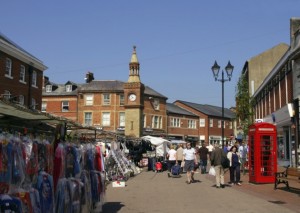
The previous location of the phone box outside HSBC
In 1953 Queen Elizabeth had all crowns changed to the St Edward’s Crown, the Coronation crown and the kiosk on Moor Street has this crown, dating it to around 1953.
Ormskirk’s growing modern population living on the new estates around the outskirts of the town relied on these kiosks as their main form of emergency contact. Home phones were not a common service in many homes in the 1930s, 40’s, 50’s and even 60’s. The town was well served for kiosks though, with town centre ones at the (old) Bus Station on Knowsley Road, on Moor Street outside what is now Middleton’s cycles, three outside the main Post Office and further out there were boxes on Tower Hill, near Hallsworth’s, Thompson Avenue, outside Pigott’s and Dyers Lane as well as on County Road near the Fire Station and Scott Estate.
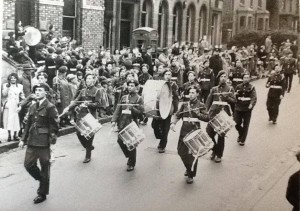
The Grade II listed kiosk on Derby Street can be seen in the background of this photo taken c. 1950
The essential service they provided meant that people have clear memories of the occasions when these kiosks played an important part in their lives whether it was ringing the midwife in the middle of the night, contacting the police in an emergency or just using it to ring school friends / sweethearts who were waiting outside their local box for a pre-arranged call.
Next time you pass your local kiosk take a moment to appreciate its iconic status and the role it has played in our developing world of technology.
Ormskirk Bygone Times have a mobile display available for any local group or event, the display covers a vast array of stories and histories of the townspeople and buildings
Market Cross or Horology Square?
Market Cross or Horology Square?
In the years before the Ormskirk Clock Tower was erected in 1876, there had been nothing to identify the spot but the name Market Cross. No structure or marker has been in situ for generations. The name may even derive from the road system and there may never have been an actual cross there at all. Certainly when tenders were invited for the design and build of the tower, one local whit wrote to the Advertiser suggesting, ‘ Surely the archives of our semi-fossilised Court Leet would throw some light on the architectural form of this ancient Cross, and if no member of that venerable body is of an antiquarian turn of mind, they might mortify the flesh by denying themselves the periodical dinners, and divert the proceeds to employ a gentleman with a taste for routing amongst what Carlyle called their “dry-as-dust “ accumulations……’
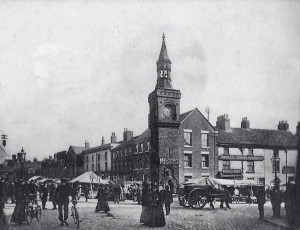 Market Place was used as the address for the businesses on each corner. In the 1820s, Bookseller Wm Leak’s printers and circulating library was at the corner of Aughton Street and Moor Street, with the George & Dragon on the corner of Church Street and Aughton Street , the Eagle & Child at the corner of Church Street and Burscough Street and Owen’s Ironmongers on the corner of Burscough Street and Moor Street.
Market Place was used as the address for the businesses on each corner. In the 1820s, Bookseller Wm Leak’s printers and circulating library was at the corner of Aughton Street and Moor Street, with the George & Dragon on the corner of Church Street and Aughton Street , the Eagle & Child at the corner of Church Street and Burscough Street and Owen’s Ironmongers on the corner of Burscough Street and Moor Street.
The width of Moor Street merging with the narrowness of Church Street isn’t really an issue in modern times, but for those who remember the through traffic, especially on Market Days or coupled with Southport Flower Show, will truly know the meaning of traffic congestion. Add that to the traffic lights at the clock and buses or Westbrook Lorries turning into and up from Aughton Street, it was a risky place to cross at any time.
Some of the businesses used the Market Cross address into the 1900s, Mawdsleys famous gingerbread bakers just used ‘The Cross’ as their address.
HP Radio on the corner of Moor Street and Burscough Street. Photograph courtesy of the Gallagher family
The George & Dragon became the National Westminster bank, The Eagle & Child became Stoners, then Kirk’s, then briefly Lawrence’s butchers and was for many years Johnson’s the cleaners when the business moved from Moor Street.
Owen’s Ironmongers became Pennington’s Tailors in the early 1900s, it was HP Radio for a good while, Collingwood Jewellers in the 80s and then H. Samuels.
Martin’s Bank held it’s position for many years and the building has remained a bastian of financial service to the town.
Images before the Clock Tower are pretty rare but one day something may turn up.




